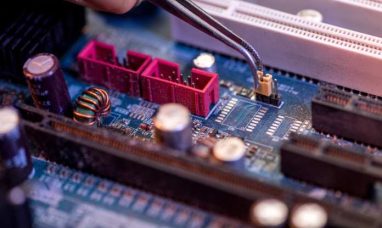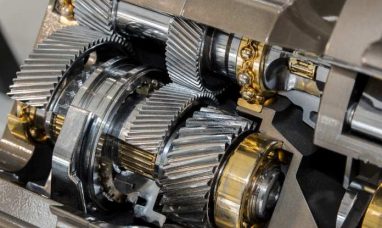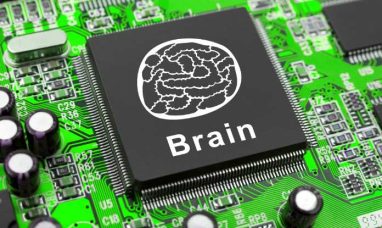This Post Was Syndicated Under License Via QuoteMedia
— 3rd Gen AMD Ryzen™ desktop processor family based on new high-performance “Zen 2” core includes highest performance 12 core desktop processor ever1 —
— New RDNA gaming architecture and upcoming AMD Radeon™ RX 5700-series graphics cards will accelerate the future of PC, console, and cloud gaming —
— World’s first PCIe® 4.0 ready desktop PC platform with broadest ecosystem readiness in AMD history planned for July 2019 —
SANTA CLARA, Calif., May 26, 2019 (GLOBE NEWSWIRE) — AMD (NASDAQ: AMD) today again made technology history with the announcement of high-performance 7nm-based computing and graphics products that are expected to deliver new levels of performance, features and experiences for PC gamers, enthusiasts and content creators. During the first-ever Computex opening keynote, AMD President and CEO Dr. Lisa Su announced:
- The new “Zen 2” core widely outperforms the historical generational performance improvement industry trend, up to 15% estimated instructions per clock (IPC)2 uplift over the predecessor “Zen” architecture. The “Zen 2” CPU core powering the next-generation AMD Ryzen and EPYC™ processors also includes significant design improvements including lager cache sizes and a redesigned floating point engine.
- The 3rd Gen AMD Ryzen desktop processor family, including the new 12-core Ryzen 9 processor, offers leadership performance.1
- The AMD X570 chipset for socket AM4, the world’s first PCIe 4.0 supported chipset with more than 50 new motherboards at launch.
- RDNA gaming architecture designed to drive the future of PC gaming, console, and cloud, anticipated to deliver incredible performance, power, and memory efficiency in a smaller package.
- The 7nm AMD Radeon RX 5700-series gaming graphics card family featuring high-speed GDDR6 memory and support for the PCIe 4.0 interface.
Dr. Su was joined by fellow technology leaders Microsoft Corporate Vice President of OS Platforms Roanne Sones, Asus Chief Operating Officer Joe Hsieh, Acer Co-Chief Operating Officer Jerry Kao and a host of other significant industry players to showcase the breadth and depth of the AMD high-performance computing and graphics ecosystem.
“2019 is off to an incredible start for AMD as we celebrate 50 years of innovation by delivering leadership products to push the limits of what is possible with computing and graphics technology,” said Dr. Su. “We made significant strategic investments in next-generation cores, a breakthrough chiplet design approach, and advanced process technologies to deliver leadership 7nm products to our high-performance computing ecosystem. We are extremely excited to kick-off Computex 2019 together with our industry partners as we prepare to bring our next generation of Ryzen desktop and EPYC server processors and Radeon RX gaming graphics cards to market.”
AMD High-Performance Desktop Updates
Continuing its path of PC leadership and industry firsts, AMD announced the 3rd Gen AMD Ryzen desktop processor, the most advanced desktop processor in the world3 with ground-breaking performance across gaming, productivity, and content creation applications. Based on the new “Zen 2” core architecture with AMD chiplet design approach, 3rd Gen AMD Ryzen desktop processors are expected to offer more performance-critical on-die cache than ever before to unleash elite gaming performance. Additionally, all 3rd Gen Ryzen desktop processors are supported by the world’s first PCIe 4.0 PC readiness for the most advanced motherboards, graphics, and storage technologies available, setting a new standard of performance and providing the ultimate consumer experience.
With the 3rd Gen AMD Ryzen desktop processor family, AMD introduced a new category of Ryzen 9 desktop processor with the flagship 12 core/24 thread Ryzen 9 3900X. Pushing the high-performance envelope for socket AM4 by offering leadership performance1, the family is rounded out with 8 core Ryzen 7 models and 6 core Ryzen 5 models.
During the keynote, Dr. Su showed various live demonstrations highlighting leadership performance of the 3rd Gen Ryzen desktop processors versus competitive production parts:
- Ryzen™ 7 3700X vs. i7-9700K with real-time rendering: The Ryzen 7 3700X offered 1% more single-threaded, and 30% more in multi-threaded performance.4
- Ryzen™ 7 3800X vs. i9-9900K with PlayerUnknown’s Battlegrounds gameplay: The Ryzen 7 3800X matched the performance of the i9-9900K.5
- Ryzen™ 9 3900X vs. i9-9920X with Blender Render: The Ryzen 9 3900X beat the Intel i9 9920X by more than 16%.6
3rd Gen AMD Ryzen Desktop Processor Line-up and Availability
| Model | Cores/ Threads |
TDP7 (Watts) | Boost/Base Freq. (GHz) | Total Cache (MB) | PCIe 4.0 Lanes (processor+AMD X570) | SEP8 (USD) | Expected Availability | |
| Ryzen™ 9 3900X CPU | 12/24 | 105W | 4.6/3.8 | 70 | 40 | $ | 499 | July 7, 2019 |
| Ryzen™ 7 3800X CPU | 8/16 | 105W | 4.5/3.9 | 36 | 40 | $ | 399 | July 7, 2019 |
| Ryzen™ 7 3700X CPU | 8/16 | 65W | 4.4/3.6 | 36 | 40 | $ | 329 | July 7, 2019 |
| Ryzen™ 5 3600X CPU | 6/12 | 95W | 4.4/3.8 | 35 | 40 | $ | 249 | July 7, 2019 |
| Ryzen™ 5 3600 CPU | 6/12 | 65W | 4.2/3.6 | 35 | 40 | $ | 199 | July 7, 2019 |
AMD also introduced a new X570 chipset for socket AM4, supporting the world’s first PCIe 4.0 readiness, which exhibited 42% faster storage performance than PCIe 3.09, enabling high-performance graphics card, networking devices, NVMe drives, and more. With PCIe 4.0 doubling the bandwidth for motherboards with the X570 chipset over PCIe 3.0, PC enthusiasts can gain more performance and flexibility when building custom systems. The X570 offers the broadest ecosystem readiness in AMD history, with over 50 new motherboard models anticipated from ASRock, Asus, Colorful, Gigabyte, MSI, as well as PCIe 4.0 storage solutions from partners including Galaxy, Gigabyte, and Phison. The 3rd Gen AMD Ryzen desktop processors are expected to be available for purchase globally on July 7, 2019.
In addition, major OEMs and System Integrators, including Acer, Asus, CyberPowerPC, HP, Lenovo, and MAINGEAR reinforced strong ecosystem support for the new platforms by announcing plans to offer 3rd Gen AMD Ryzen processor-based gaming desktop systems over the coming months.
AMD High-Performance Gaming Updates
AMD unveiled RDNA, the next foundational gaming architecture that was designed to drive the future of PC gaming, console, and cloud for years to come. With a new compute unit10 design, RDNA is expected to deliver incredible performance, power and memory efficiency in a smaller package compared to the previous generation Graphics Core Next (GCN) architecture. It is projected to provide up to 1.25X higher performance-per-clock11 and up to 1.5X higher performance-per-watt over GCN12, enabling better gaming performance at lower power and reduced latency.
RDNA will power the upcoming 7nm AMD Radeon RX 5700-series graphics cards which feature high-speed GDDR6 memory and support for the PCIe 4.0 interface.
During the keynote, Dr. Su showcased the power of RDNA and one of the new AMD Radeon RX 5700-series graphics cards in a head-to-head comparison with a RTX 2070 card running a Strange Brigade gameplay demo, beating the competition delivering incredible ~100 FPS gaming.13
AMD Radeon RX 5700-series graphics cards are expected to be available in July 2019. Learn more at the AMD E3 livestream event on June 10, 2019 at 3 pm PT.
AMD Datacenter Updates
The AMD datacenter business continues to gain traction with customers, winning in application workloads from the biggest cloud environments to exascale supercomputing, and capitalizing on the massive market opportunity for both AMD EPYC and AMD Radeon Instinct™ processors.
During the keynote, Dr. Su continued the anticipation around the next-generation AMD EPYC processors with the first public competitive demonstration of a 2nd Gen AMD EPYC server platform. The demonstration showed a 2P 2nd Gen AMD EPYC based server vs. a 2P Intel Xeon® 8280-based server running a NAMD Apo1 v2.12 benchmark test. The preproduction 2nd Gen AMD EPYC processor powered server outperformed the Intel Xeon powered servers by more than 2x on the NAMD benchmark.14
Finally, Microsoft Azure announced the achievement of previously unobtainable levels of performance for computational fluid dynamics (CFD) using an Azure HB cloud instance running on an 1st Gen AMD EPYC-processor based system. Leveraging the exceptional memory bandwidth of AMD EPYC, Azure HB scaled Siemens Star -CCM+ application across over 11,500 cores using a Le Mans 100 Million Cell simulation, well beyond the never before achieved 10,000 cores goal. “HB-series VMs on Azure are a game changer for HPC in the cloud. For the first time, HPC customers can scale their MPI workloads to tens of thousands of cores with the agility of the cloud and performance and economics that rival on-premise cluster,” said Navneet Joneja, head of product for Azure Virtual Machines, Microsoft Corp. “We look forward to this new Azure offering doing great things for HPC-driven innovation and productivity.”
The 2nd Gen AMD EPYC server processor family is projected to deliver up to 2X the performance-per socket15 and up to 4X the floating performance-per-socket16 over the previous generation.
The 2nd Gen AMD EPYC server processor family is expected to launch in Q3 2019.
Supporting Resources
- Visit the AMD Computex webpage for a full replay of the keynote, videos and product details
- Become a fan of AMD on Facebook
- Follow AMD on Twitter
About AMD
For 50 years AMD has driven innovation in high-performance computing, graphics and visualization technologies ― the building blocks for gaming, immersive platforms and the datacenter. Hundreds of millions of consumers, leading Fortune 500 businesses and cutting-edge scientific research facilities around the world rely on AMD technology daily to improve how they live, work and play. AMD employees around the world are focused on building great products that push the boundaries of what is possible. For more information about how AMD is enabling today and inspiring tomorrow, visit the AMD (NASDAQ:AMD) website, blog, Facebook and Twitter pages.
Cautionary Statement
This press release contains forward-looking statements concerning Advanced Micro Devices, Inc. (AMD) including the features, functionality, availability, timing, deployment and expectations of AMD’s future products, including 3rd Gen AMD Ryzen desktop processors, 7nm AMD Radeon RX 5700-series graphics cards and the 2nd Gen AMD EPYC server processor family, which are made pursuant to the Safe Harbor provisions of the Private Securities Litigation Reform Act of 1995. Forward-looking statements are commonly identified by words such as “would,” “intends,” “believes,” “expects,” “may,” “will,” “should,” “seeks,” “intends,” “plans,” “pro forma,” “estimates,” “anticipates,” or the negative of these words and phrases, other variations of these words and phrases or comparable terminology. Investors are cautioned that the forward-looking statements in this document are based on current beliefs, assumptions and expectations, speak only as of the date of this document and involve risks and uncertainties that could cause actual results to differ materially from current expectations. Such statements are subject to certain known and unknown risks and uncertainties, many of which are difficult to predict and generally beyond AMD’s control, that could cause actual results and other future events to differ materially from those expressed in, or implied or projected by, the forward-looking information and statements. Material factors that could cause actual results to differ materially from current expectations include, without limitation, the following: Intel Corporation’s dominance of the microprocessor market and its aggressive business practices may limit AMD’s ability to compete effectively; AMD has a wafer supply agreement with GLOBALFOUNDRIES Inc. (GF) with obligations to purchase all of its microprocessor and APU product requirements, and a certain portion of its GPU product requirements, manufactured at process nodes larger than 7 nanometer from GF with limited exceptions. If GF is not able to satisfy AMD’s manufacturing requirements, AMD’s business could be adversely impacted; AMD relies on third parties to manufacture its products, and if they are unable to do so on a timely basis in sufficient quantities and using competitive technologies, AMD’s business could be materially adversely affected; failure to achieve expected manufacturing yields for AMD’s products could negatively impact its financial results; the success of AMD’s business is dependent upon its ability to introduce products on a timely basis with features and performance levels that provide value to its customers while supporting and coinciding with significant industry transitions; if AMD cannot generate sufficient revenue and operating cash flow or obtain external financing, it may face a cash shortfall and be unable to make all of its planned investments in research and development or other strategic investments; the loss of a significant customer may have a material adverse effect on AMD; AMD’s receipt of revenue from its semi-custom SoC products is dependent upon its technology being designed into third-party products and the success of those products; global economic and market uncertainty may adversely impact AMD’s business and operating results; AMD’s products may be subject to security vulnerabilities that could have a material adverse effect on AMD; IT outages, data loss, data breaches and cyber-attacks could compromise AMD’s intellectual property or other sensitive information, be costly to remediate and cause significant damage to its business, reputation and operations; AMD’s operating results are subject to quarterly and seasonal sales patterns; AMD may not be able to generate sufficient cash to service its debt obligations or meet its working capital requirements; AMD has a large amount of indebtedness which could adversely affect its financial position and prevent it from implementing its strategy or fulfilling its contractual obligations; the agreements governing AMD’s notes and the Secured Revolving Line of Credit impose restrictions on AMD that may adversely affect AMD’s ability to operate its business; the markets in which AMD’s products are sold are highly competitive; AMD’s worldwide operations are subject to political, legal and economic risks and natural disasters, which could have a material adverse effect on it; the conversion of the 2.125% Convertible Senior Notes due 2026 may dilute the ownership interest of AMD’s existing stockholders, or may otherwise depress the price of its common stock; uncertainties involving the ordering and shipment of AMD’s products could materially adversely affect it; the demand for AMD’s products depends in part on the market conditions in the industries into which they are sold. Fluctuations in demand for AMD’s products or a market decline in any of these industries could have a material adverse effect on its results of operations; AMD’s ability to design and introduce new products in a timely manner is dependent upon third-party intellectual property; AMD depends on third-party companies for the design, manufacture and supply of motherboards, software and other computer platform components to support its business; if AMD loses Microsoft Corporation’s support for its products or other software vendors do not design and develop software to run on AMD’s products, its ability to sell its products could be materially adversely affected; and AMD’s reliance on third-party distributors and add-in-board partners subjects it to certain risks. Investors are urged to review in detail the risks and uncertainties in AMD’s Securities and Exchange Commission filings, including but not limited to AMD’s Quarterly Report on Form 10-Q for the quarter ended March 30, 2019.
AMD, the AMD Arrow logo, EPYC, Ryzen, Radeon and combinations thereof, are trademarks of Advanced Micro Devices, Inc. Other names are for informational purposes only and may be trademarks of their respective owners.
1 Testing by AMD Performance Labs as of 05/26/2019 utilizing the Ryzen 9 3900X vs. Core i9-9920X in Cinebench R20 nT. Results may vary. RZ3-13
2 Testing by AMD Performance Labs as of 5/23.2918 AMD “Zen2” CPU-based system scored an estimated 15% higher than previous generation AMD “Zen” based system using estimated SPECint®_rate_base2006 results. SPEC and SPECint are registered trademarks of the Standard Performance Evaluation Corporation. See www.spec.org. GD-141
3 “Advanced” defined as superior process technology in a smaller node and unique support for PCIe® Gen 4 in the gaming market as of 05/26/2019. RZ3-14
4 Testing by AMD Performance Labs as of 05/26/2019 utilizing the Ryzen 7 3700X vs. Core i7-9700K in Cinebench R20 1T and nT. Results may vary. RZ3-15
5 Testing by AMD Performance Labs as of 05/26/2019 utilizing the Ryzen 7 3800X and Core i9-9900K in PUBG. Results may vary. RZ3-16
6 Testing by AMD Performance Labs as of 05/26/2019 utilizing the Ryzen 9 3900X vs. Core i9-9920X in Cinebench R20 nT. Results may vary. RZ3-17
7 Though both are often measured in watts, it is important to distinguish between thermal and electrical watts. Thermal wattage for processors is conveyed via thermal design power (TDP). TDP is a calculated value that conveys an appropriate thermal solution to achieve the intended operation of a processor. Electrical watts are not a variable in the TDP calculation. By design, electrical watts can vary from workload to workload and may exceed thermal watts. GD-109
8 Suggest online retailer price in US dollars as of 5/23/2019.
9 Testing as of 05/20/2019 by AMD Performance Labs using a 3rd Gen AMD Ryzen™ Processor in Crystal DiskMark 6.0.2. Results may vary with configuration. RZ3-12
10 AMD APUs and GPUs based on the Graphics Core Next and RDNA architectures contain GPU Cores comprised of compute units, which are defined as 64 shaders (or stream processors) working together. GD-142
11 Testing done by AMD performance labs 5/23/19, showing a geomean of 1.25x per/clock across 30 different games @ 4K Ultra, 4xAA settings. Performance may vary based on use of latest drivers. RX-327
12 Testing done by AMD performance labs 5/23/19, using the Division 2 @ 25×14 Ultra settings. Performance may vary based on use of latest drivers. RX-325
13 Testing done by AMD performance labs 5/23/19, using the Strange Brigade @ 25×14 Ultra settings. Performance may vary based on use of latest drivers. RX-328
14 Preproduction 7nm 2nd Generation EPYC™ powered server CPU in a 2P server configuration outperformed 2P Intel Xeon 8280 powered server by an average of up to 2X on the NAMD benchmark. AMD internal testing as of May 21, 2019. Production silicon results may vary. ROM-05
15 Testing performed by AMD Engineering as of October 2018 using AMD reference system with a preproduction “Rome” engineering sample, where “Rome” scored approximately 2x higher compared to “Naples” System. Actual results with production silicon may vary. ROM-03
16 Estimated generational increase based upon AMD internal design specifications for “Zen 2” compared to “Zen 1”. “Zen 2” has 2X the core density of “Zen 1”, and when multiplied by 2X peak FLOPs per core, at the same frequency, results in 4X the FLOPs in throughput. Actual results with production silicon may vary. ROM-04
Contact:
Deb Nations
AMD Communications
(512) 602-1025
[email protected]
Laura Graves
AMD Investor Relations
(408) 749-5467
[email protected]









